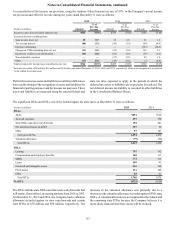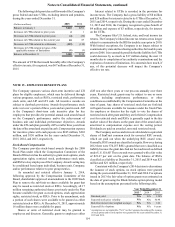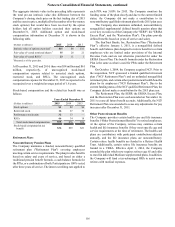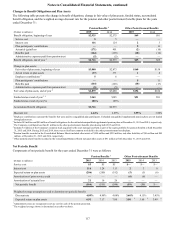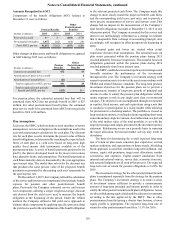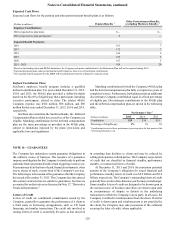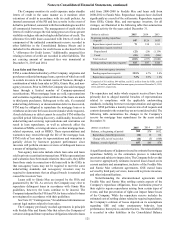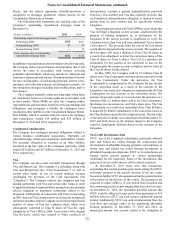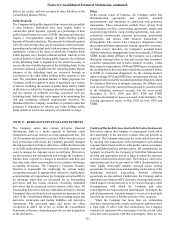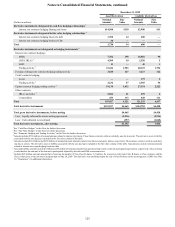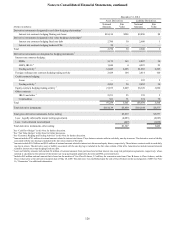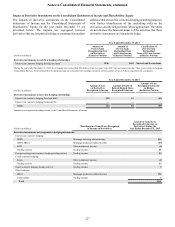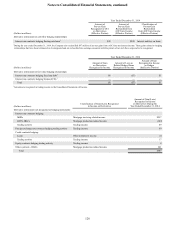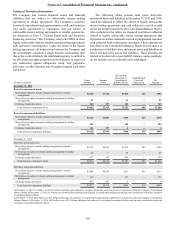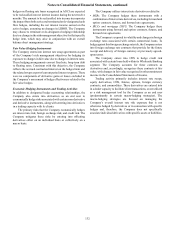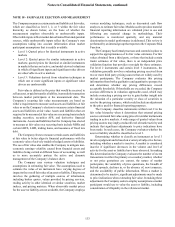SunTrust 2015 Annual Report Download - page 151
Download and view the complete annual report
Please find page 151 of the 2015 SunTrust annual report below. You can navigate through the pages in the report by either clicking on the pages listed below, or by using the keyword search tool below to find specific information within the annual report.Notes to Consolidated Financial Statements, continued
123
deliver tax credits, and was recorded in other liabilities in the
Consolidated Balance Sheets.
Public Deposits
The Company holds public deposits from various states in which
it does business. Individual state laws require banks to
collateralize public deposits, typically as a percentage of their
public deposit balance in excess of FDIC insurance and may also
require a cross-guarantee among all banks holding public
deposits of the individual state. The amount of collateral required
varies by state and may also vary by institution within each state,
depending on the individual state's risk assessment of depository
institutions. Certain of the states in which the Company holds
public deposits use a pooled collateral method, whereby in the
event of default of a bank holding public deposits, the collateral
of the defaulting bank is liquidated to the extent necessary to
recover the loss of public deposits of the defaulting bank. To the
extent the collateral is insufficient, the remaining public deposit
balances of the defaulting bank are recovered through an
assessment of the other banks holding public deposits in that
state. The maximum potential amount of future payments the
Company could be required to make is dependent on a variety
of factors, including the amount of public funds held by banks
in the states in which the Company also holds public deposits
and the amount of collateral coverage associated with any
defaulting bank. Individual states appear to be monitoring this
risk and evaluating collateral requirements; therefore, the
likelihood that the Company would have to perform under this
guarantee is dependent on whether any banks holding public
funds default as well as the adequacy of collateral coverage.
Other
In the normal course of business, the Company enters into
indemnification agreements and provides standard
representations and warranties in connection with numerous
transactions. These transactions include those arising from
securitization activities, underwriting agreements, merger and
acquisition agreements, swap clearing agreements, loan sales,
contractual commitments, payment processing, sponsorship
agreements, and various other business transactions or
arrangements. The extent of the Company's obligations under
these indemnification agreements depends upon the occurrence
of future events; therefore, the Company's potential future
liability under these arrangements is not determinable. STIS and
STRH, broker-dealer affiliates of the Company, use a common
third party clearing broker to clear and execute their customers'
securities transactions and to hold customer accounts. Under
their respective agreements, STIS and STRH agree to indemnify
the clearing broker for losses that result from a customer's failure
to fulfill its contractual obligations. As the clearing broker's
rights to charge STIS and STRH have no maximum amount, the
Company believes that the maximum potential obligation cannot
be estimated. However, to mitigate exposure, the affiliate may
seek recourse from the customer through cash or securities held
in the defaulting customers' account. For the years ended
December 31, 2015, 2014, and 2013, STIS and STRH
experienced minimal net losses as a result of the indemnity. The
clearing agreements expire in May 2020 for both STIS and
STRH.
NOTE 17 - DERIVATIVE FINANCIAL INSTRUMENTS
The Company enters into various derivative financial
instruments, both in a dealer capacity to facilitate client
transactions and as an end user as a risk management tool. The
ALCO monitors all derivative activities. When derivatives have
been entered into with clients, the Company generally manages
the risk associated with these derivatives within the framework
of its VAR methodology that monitors total daily exposure and
seeks to manage the exposure on an overall basis. Derivatives
are also used as a risk management tool to hedge the Company’s
balance sheet exposure to changes in identified cash flow and
fair value risks, either economically or in accordance with hedge
accounting provisions. The Company’s Corporate Treasury
function is responsible for employing the various hedge
accounting strategies to manage these objectives. Additionally,
as a normal part of its operations, the Company enters into IRLCs
on mortgage loans that are accounted for as freestanding
derivatives and has certain contracts containing embedded
derivatives that are measured, in their entirety, at fair value. All
freestanding derivatives and any embedded derivatives that the
Company bifurcates from the host contracts are measured at fair
value in the Consolidated Balance Sheets in trading assets and
derivative instruments and trading liabilities and derivative
instruments. The associated gains and losses are either
recognized in AOCI, net of tax, or within the Consolidated
Statements of Income, depending upon the use and designation
of the derivatives.
Credit and Market Risk Associated with Derivative Instruments
Derivatives expose the Company to counterparty credit risk if
the counterparty to the derivative contract does not perform as
expected. The Company minimizes the credit risk of derivatives
by entering into transactions with counterparties with defined
exposure limits based on their credit quality and in accordance
with established policies and procedures. All counterparties are
regularly reviewed by the Company’s Credit Risk Management
division and appropriate action is taken to adjust the exposure
to certain counterparties as necessary. The Company’s derivative
transactions may also be governed by ISDA documentation or
other legally enforceable industry standard master netting
agreements. In certain cases and depending on the nature of the
underlying derivative transactions, bilateral collateral
agreements are also utilized. Furthermore, the Company and its
subsidiaries are subject to OTC derivative clearing requirements,
which require certain derivatives to be cleared through central
clearinghouses with which the Company and other
counterparties are required to post initial margin. To mitigate the
risk of non-payment, variation margin is received or paid daily
based on the net asset or liability position of the contracts.
When the Company has more than one outstanding
derivative transaction with a single counterparty, and there exists
a legal right of offset with that counterparty, the Company
considers its exposure to the counterparty to be the net fair value
of its derivative positions with that counterparty. If the net fair


